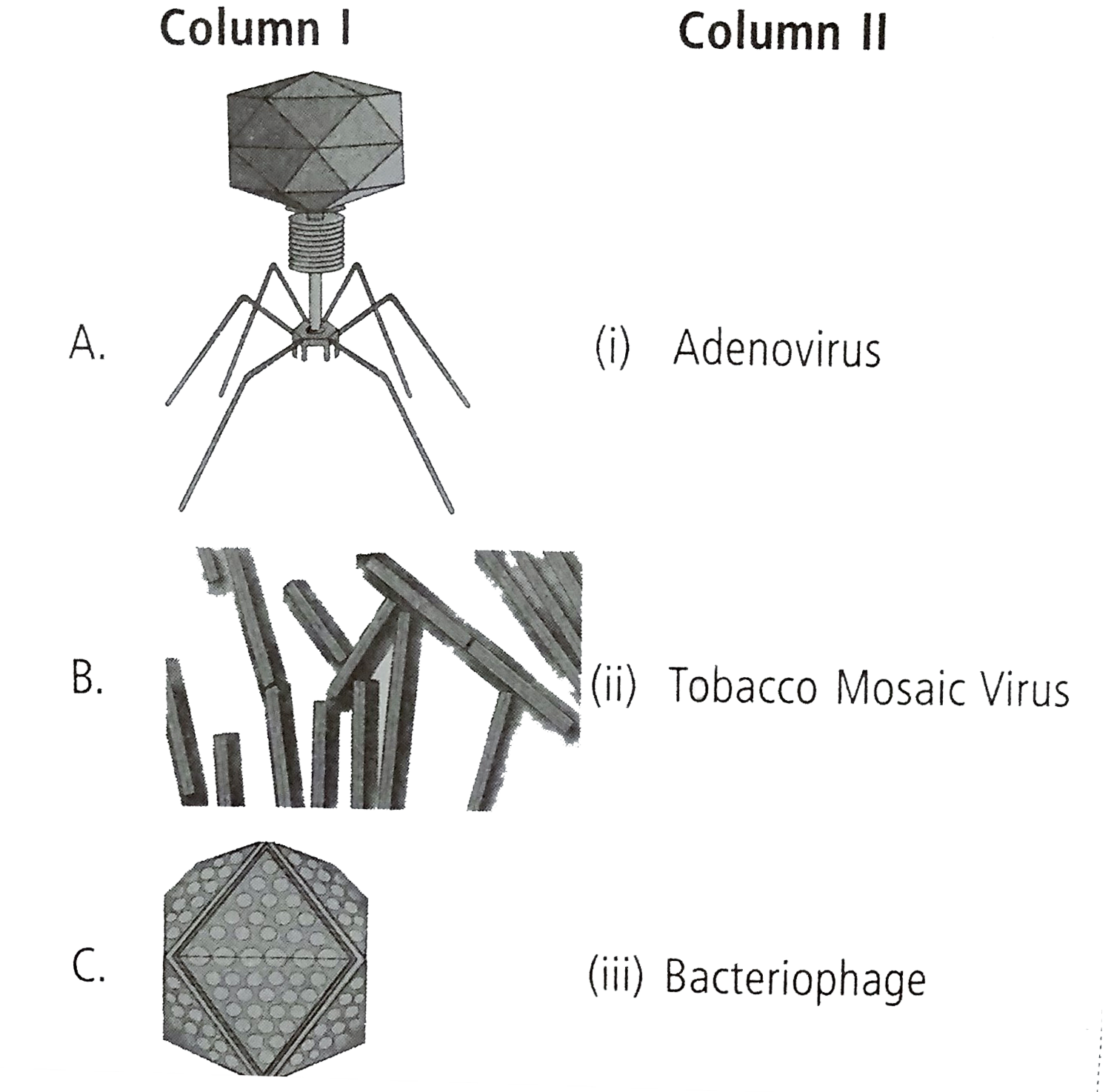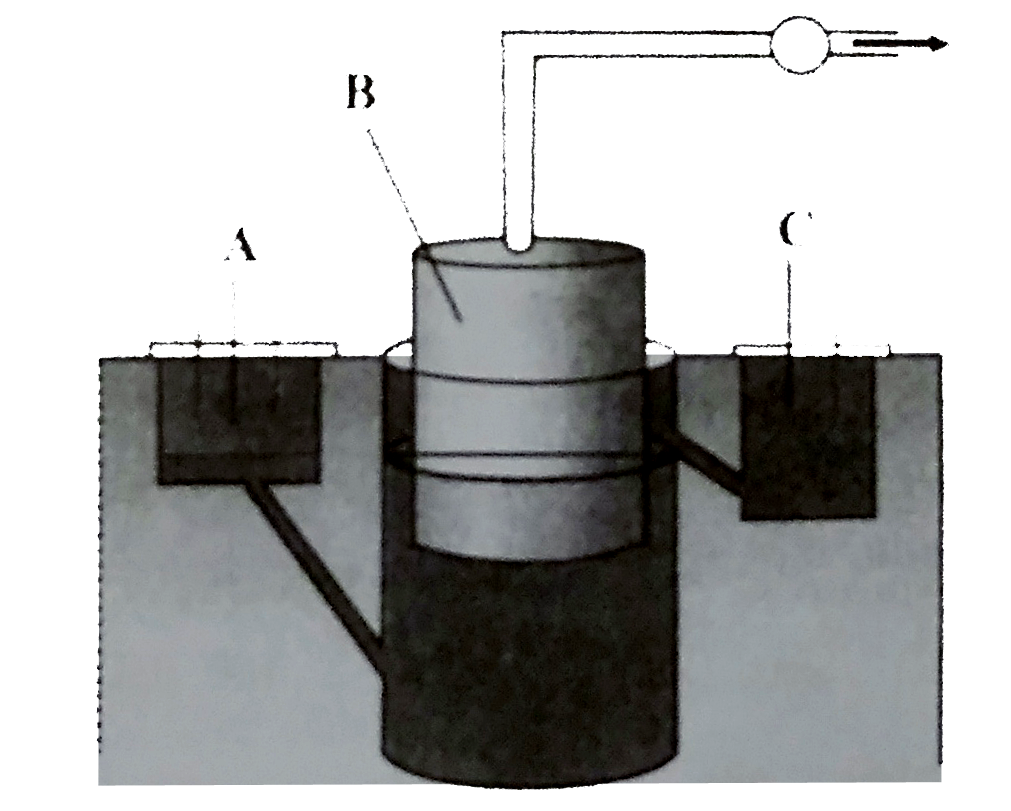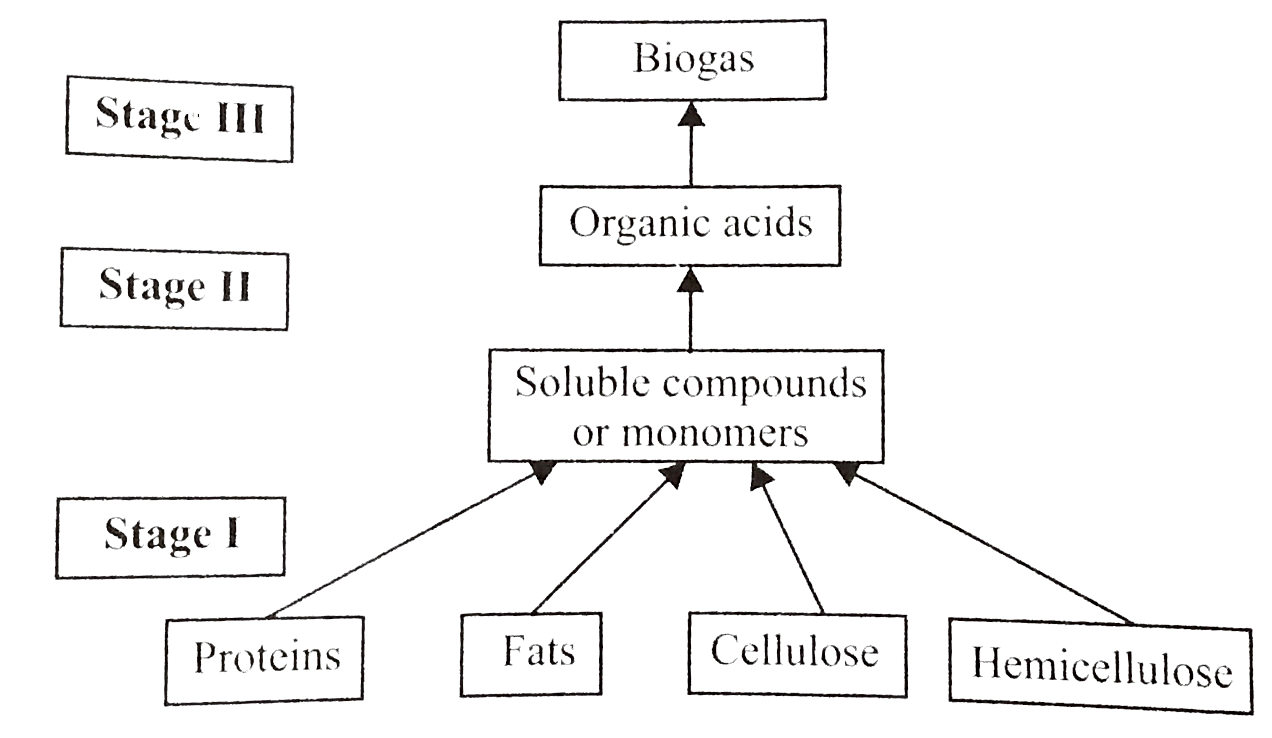Complete Solutions to Microbes In Human Welfare of chapter MICROBES IN HUMAN WELFARE of Class 12 book with complete answers and questions
| Class 12 | BIOLOGY |
| Chapter | MICROBES IN HUMAN WELFARE |
| NCERT FINGERTIPS | Microbes In Human Welfare |
| Number Of Questions | 100 |
| Academic Year | 2023-24 |
Microbes are present in
03:11View SolutionWhich of the following microbes is a proteinaceous infectious agent?
03:00View SolutionMatch column I with column II and select the correct answer from the give codes.
 04:06View Solution
04:06View SolutionRefer to the given figure and select the correct match.
 03:36View Solution
03:36View SolutionThe nutritive medium for growing bacteria and many fungi in laboraory is called
02:02View SolutionThe inoculum is added to the fresk milk in order to convert milk into curd, the term 'inoculum' here refers to
03:27View SolutionStudy the following statements regarding lactic acid bacteria `(LAB)` which are used to convert milk into curd.
(i) They produce acids that coagulate and partially digest the milk proteins.
(ii) A small amount of curd added to the fresh milk as an inoculum contains millions of `LAB`, which at suitable temperature, multiply and convert milk into curd.
(iii) Conversion of milk into curd improves its nutritional quality by increasing vitamin `B_(12)`.
(v) LAB may result in acidity in the stomach of human beings.
Which of the given statements are correct ?06:36View SolutionStudy the following flow chart depicting the formation of curd from milk. Identify the missing parts X and Y.
 04:15View Solution
04:15View SolutionRead the following statements and select the correct option.
Statement 1: Besides curdling of milk, LAB also improve its nutritional quality by increasing vitamin `B_(12)`.
Statement 2: LAB, when present in human stomach, check disease causing microbes.01:40View SolutionWhich one of the following combinations of organisms are responsible for the formation and flavour of yoghurt
01:29View SolutionWhich of the following food items is produced by the fermenting activity of microbes?
A. ldli B. Dosa
C. Toddy D. Cheese01:55View SolutionRead the following statements and select the incorrect one.
03:40View SolutionMatch different organisms in column I with their uses in column I and select the correct answer from the given codes.
`{:(Column I, Column II),(A."Lactobacillus acidophilus",(i)"Formation of dough"),(B."Saccharomyces cerevisiae",(ii)"Single cell proteins"),(C. "Propionibacterium shermanii",(iii)"Conversion of milk into curd"),(D."Spirullina",(iv)"Formation of Swiss cheese"):}`04:19View SolutionWhich of the following organisms is used in the production of beverages?
03:09View SolutionWhich of the following options contains the end products formed during anaerobic respiration in yeast?
04:06View SolutionWine and beer are produced directly by fermentation whereas brandy and whisky require both fermentation and distillation. This is because
04:15View SolutionThe chemical substances produced by some microbes which can kill or inhibit the growth of other microbes are called
02:51View SolutionAntibiotics are obtained from
01:49View SolutionWhich of the following antibiotics was extensively used to treat American soldiers wounded in World War II ?
02:40View SolutionWhich of the following statements regarding antibiotics is not correct ?
(i) Antibiotics are the attenuated microorganisms which in small concentration can kill or retard the growth of other harmful microorganisms.
(ii) Penicillin was the first antibiotic discovered by Alexander Fleming (1928) while working on bacterium Staphylococcus aureus.
(iii) The full potential of penicillin as an effective antibiotic was established by Ernest chain and Howard Florey.
(iv) Fleming, Chain and Florey were awarded the Nobel Prize in 194503:35View SolutionWhich of the following discases are treated by antibiotics ?
(i) Plague (ii) Diphtheria
(iii) Leprosy (iv) Whooping cough03:10View SolutionStreptomycin is obtained from
02:27View SolutionWhich of the following antibiotics is not correctly matched with the source from which it is obtained ?
02:49View SolutionSelect the correct option to fill up the blanks.
(i) ___________are used in detergent formulations and are helpful in removing oily stains from the laundry.
(ii) _____________are ripened by growing Penicillium roqueforti on them.
(iii) ___________are produced without distillation whereas,__________are produced by distillation of the fermented broth.
(iv) ___________antibiotic was used to teat American soldiers wounded in world war II.
(v) _______is also called as Kusht rog.04:08View Solution___________produced by bacterium Streptococcus and modified by genetic engineering is used as a clot buster for removing clots from the blood vessels of patients who have undergone myocardial infarction leading to heart attack.
02:54View SolutionEnzyme which has the fibrinolytic effect is
02:10View SolutionIdentify the blank spaces A,B,C and D in the following table and select the correct answer.
`{:("Type of microbe","Scientific name","Commercial product"),("Bacterium",A,"Streptokinase"),(B,"Aspergillus niger","Citric acid"),("Fungus","Trichonderma polysporum",C),("Bacterium",D,"Butyric acid"):}`05:45View SolutionA drug used for patient A is obtained from the organism B. Identify A and B in the above statement and select the correct answer.
02:56View SolutionStains used for lowering blood cholesterol level are extracted from
03:55View SolutionMonascus purpureus is a yeast commerically used in the production of
03:41View SolutionIdentify the blank spaces A,B,C and D in the table given below and select the correct answer.
`{:("type of microbe","Scientific name","Product","Medical application"),("Fungs",A,"Cyclosporin A",B),(C,"Monascus purpuereus","Statin",D):}`05:22View SolutionIdentify the blanks spaces A,B,C and D in the following table and select the correct answer.
`{:("Type of microbe","Scientific name","Commercial product"),("Bacterium",A,"Lactic acid"),("Fungus",B,"Cyclosporin A"),(C,"Monascus purpureus","Statins"),("Fungus","Penicillium notatum",D):}`05:59View Solution_______is the first step of sewage treatment.
03:15View SolutionDuring the primary treatment of sewage, solid paricles that settle down are called
06:14View SolutionThe purpose of biological treatment of waste water is to
02:12View SolutionThe masses of bacteria held together by slime and fungal filaments to form mesh-like structures are called as
02:41View SolutionRead the following statements and select the correct option.
Statement 1 : BOD represents the amount of dissolved oxygen that would be consumed if all the organic matter in one litre of water were oxidised by microorganisms.
Statement 2 : High value of BOD indicates that water is highly polluted by organic matter.03:00View SolutionBOD is_____in polluted water and ________in potable water.
04:43View SolutionBiochemical oxygeb demand (BOD) in a river water
02:53View SolutionWhen domestic sewage mixes with river water
04:14View SolutionA sewage treatement process in which a part of decomposer bacteria present in the waste is recycled into the starting of the process is called as
04:51View SolutionIn the sewage treatment, bacterial flocs are allowed to sediment in a setting tank. This sediment is called as
02:46View SolutionMatch column I with column II and select the correct answer from the given codes.
`{:(Column I,Column II),(A. "The stage in which of physical treatment of sewage is done",(i)"Anaerobic digestion activated sludge and production of biogas"),(B."The stage in which biological treatment of sewage is done",(ii)"Activated sludge"),(C."Name of the sediment in primary treatment",(iii)"Aeration tanks"),(D."It is carried to aeration tanks from primary",(iv)"Primary effluent"),(E."Name of the sediment in secondary treatment",(v)"Primary sludge"),(F."site of flocs growth",(vi)"Secondary treatment"),(G."Function of sludge digester",(vii)"Primary treatment"):}`View SolutionGiven below is the flow chart of sewage treatement. Identify A,B,C and D and select the correct option.
 06:40View Solution
06:40View SolutionRead the following statements and select the incorrect one.
02:50View SolutionSelect the correct statement regarding activated sludge formed during secondary sewage treatment.
02:34View SolutionWhich of the following steps is taken by the Ministry of Enviornment and Forests to protect rivers from water pollution?
03:56View SolutionMach column I with column II and select the correct answer from the given codes.
`{:(ColumnI, Column II),(A."Methanogens",(i)BOD),(B."Fermentors",(ii)"Methane rich fuel gas"),(C."Organic waste in water",(iii)"Production of methane"),(D."Biogas",(iv)"Large vessels for growing microbes"):}`05:59View SolutionStudy the following statements and select the incorrect ones.
(i) Physical removal of large and small particles through filtration and sedimentation is called primary sewage treatment.
(ii) Secondary sewage treatment is mainly a mechanical process.
(iii) Activated sludge sediment in a sewage treatment plant is a rich source of aeroic bacteria.
(iv) Biogas, commonly called as gobar gas, is pure methane.03:41View SolutionMethanogens, growing anaerobically on cellulosic material produce
03:33View SolutionWhich of the following bacteris is present in the rumen of cattle?
03:47View SolutionProcess of biogas production is
02:28View SolutionBiogas is produced by
03:04View SolutionMatch column I with column II and select the correct option from the codes given below.
`{:(Column I,ColumnII),(A."Statins",(i)"Biogas"),(B."Dung",(ii)"Saccharomyces cerevisae"),(C."Ethanol production",(iii)"Monascus purpureus"),(D."CyclosporinA",(iv)"Trichoderma polysporum"):}`05:50View SolutionThese bacteria grow anaerobically on cellulosic material, produce large amount of methane along with `CO_(2)` and `H_(2)`, and are collectively called as methanogens. Examples of such bacteria are
04:29View SolutionThe given figure represents a typical biogas plant. Select the correct option for A,B and C respectively.
 02:51View Solution
02:51View SolutionWhich of the following statements is incorrect ?
04:39View SolutionBiogas generation is a three stage anaerobic digestion of animal and other organic wastes. Study the following flow chart and select the correct option for stages I, II and III.
 03:37View Solution
03:37View SolutionRead the following statements and select the correct option.
Statement 1 : Biocontrol refers to the use of biological methods for controlling plant diseases and pests.
Statement 2 : Use of biocontrol measures will greatly reduce our dependence on toxic chemicals and pesticides.02:39View SolutionBiopesticides are
03:00View SolutionWhen a natural predator (living organism) is applied on the other pathogen organisms to control them, this process is called as
02:12View SolutionDragonflies are used to get rid of
View SolutionA microbial biocontrol agent that can be used to control butterfly caterpillars is
04:46View SolutionBacillus thuringiensis is used to control
02:56View SolutionBacillus thuringiensis (Bt) strains have been used for designing novel
View SolutionFill up the blanks by selecting the correct option.
(i) Biogas is a mixture of gases which predominantly contains______and is used as_______
(ii) Methanogens are commonly found in the__________during sewage treatment.
(iii) ___________species are free-living fungi and effective biocontrol agents of several plant pathogens.04:18View SolutionWhich of the following statements is correct with regard to biocontrol agents ?
03:30View SolutionTrichoderma harizianum has proved to be a useful microorganism for
03:33View SolutionBaculoviruses (Nucleopolyhedrobirus) do not show
03:43View SolutionWhich of the following statements regarding baculoviruses as biocontrol agents is/are correct ?
04:56View SolutionIntegrated Pest Mangement (IPM) discourages the excessive use of
05:12View SolutionWhich of the following is not used as a biopesticide ?
05:18View SolutionThe reason that the chemical/synthetic fertilisers should be replaced by biofertilisers is that the former
04:09View SolutionOrganic farming does not include
04:52View SolutionOrganic farming includes
02:45View SolutionLiving organisms used to enrich the nutrient quality of the soil are called as
03:42View SolutionBiofertilisers are prganisms that enrich the nutrient quality of the soil. Which of the following can be used as biofertilisers ?
03:01View SolutionBiofertilisers are
01:55View SolutionBiofertilisers are the living organisms which
02:47View SolutionUnicellular symbiotic organisms improve yield of legumes by
03:21View SolutionMatch column I with column II and select the correct answer from the gives codes.
`{:(Column I,Column II),(A."Trichoderma",(i)"Free living nitrogen fixing bacteria"),(B."Streptomyces",(ii)"Biocontrol agent"),(C."Azospirillum",(iii)"Lactic acid"),(D."Lactobacillus",(iv)"Source of antibiotic"):}`05:40View SolutionWhich one of the following can be used as biofertiliser in cotton field?
02:45View SolutionThe symbiotic association between fungi and roots of higher plants is referred to as
02:19View SolutionWhich one of the following microorganisms forms symbiotic assocation with plants and helps them in their nutrition?
02:51View SolutionWhich of the following statements is not correct regarding mycorrhiza ?
03:00View SolutionWhich one of the following pairs is correctly matched?
03:17View SolutionMatch column I with column II and select the correct answer from the given codes.
`{:(Column I,Column II),(A."Mycorrhizae",(i)"Azadirachtin"),(B."Bacillus thuringiensis",(ii)"Phosphours nutrition"),(C."Root nodules",(iii)"Leghaemoglobin"),(D."Biopesticide",(iv)"Bioinsecticide"):}`05:32View SolutionCyanobacteria are
03:48View SolutionA nitrogen fixing microbe associated with the fern Azolla in rice fields is
03:02View SolutionAzolla pinnata has been found to be an important biofertiliser for paddy crops. This quality is due to the presence of
03:39View SolutionWhich of the following is widely used as a successful biofertiliser in Indian rice fields ?
02:38View SolutionStudy the following statements and select the correct ones
(i) Methanogens are archeabacteria which produce methane in marshy areas
(ii) Nostoc is a filamentous blue green alga which fixes atmospheric nitrogen.
(iii) Many membres of the genus Glomus form my corrhiza.View SolutionWhich of the following statements is/are correct ?
02:37View SolutionWhich of the following options includes biofertilisers ?
03:07View SolutionWhich of the following is a non-symbiotic biofertiliser ?
02:39View SolutionNitrogen fixation in root nodules of Alnus is brought about by
03:31View SolutionFarmers have reported over `50%` higher yields of rice by using which of the following biofertilisers ?
02:41View SolutionMatch column I with column II and select the correct answer from the given codes.
`{:(Column I,Column II),(A."Ganga action plan",(i)N_(2) "fixing cyanobacterium"),(B."Bt cotton",(ii)"Ministry of environment and forests"),(C."Rhizobium",(iii)"Insect resistant plant"),(D."Nostoc",(iv)N_(2)"fixing bacterium"):}`06:24View SolutionWhich of the following statements is/are incorrect ?
(i) Cyanobacteria are autotrophic microbes widely distributed in aquatic and terrestrial habitats.
(ii) Anabaena, Nostoc and Oscillatoria are photosynthetic `N_(2)`-fixing cyanobacteria.
(iii) Tolypothrix (BGA) can increase rice production by about `20%`
(iv) BGA add organic matter to the soil and increase its fertility.
(v) In our country, biofertilisers are not available commercially in the markets for farmers.02:32View SolutionMatch column I with column II and select the correct answer from the given codes.
`{:(Column I,Column II),(A."Azolla",(i)"symbiotic" N_(2)- "fixer"),(B."Rotenone",(ii)"Symbiotic association with" N_(2)-"fixing"),(C."Crotolaria juncea",(iii)"Natural insecticide"),(D."Frankia",(iv)"Green manure"):}`View Solution
Microbes In Human Welfare questions and complete solutions for chapter MICROBES IN HUMAN WELFARE of MTG BIOLOGY (ENGLISH) of Class 12
